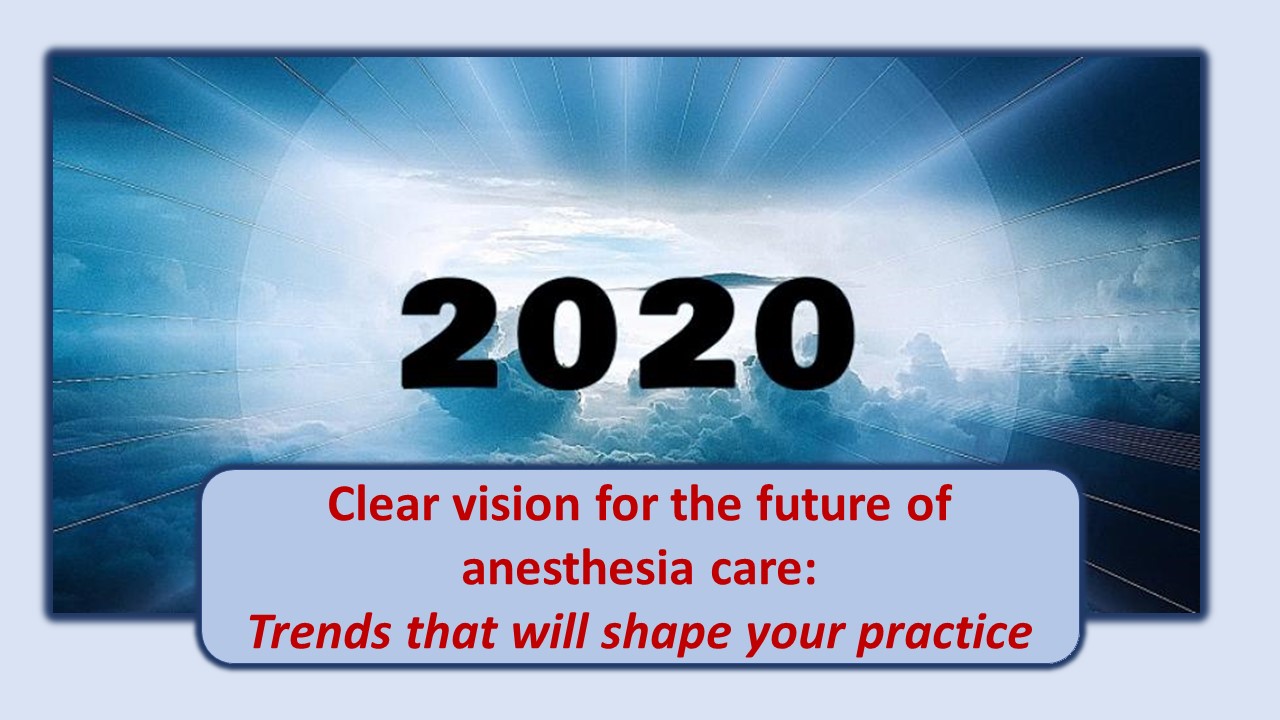By Thomas Davis, DNAP, MAE, CRNA
Follow @procrnatom on twitter
Crafty clairvoyants claiming 2020 vision, can’t wait for the New Year to arrive so they can capture the spotlight and publish their predictions. However, history reveals that although forecasts from the know-it-all pundits may have sounded logical, many predictions completely missed the mark. For example:
- In 1876 Western Union Telegraph stated that the telephone had too many flaws and zero inherent value, LOL.
- In 1954 radio host, Eddie Bond, advised Elvis to keep his day job, predicting the soon-to-be-heartthrob would never make it as a singer. And eight years later, Decca Records opted not to offer the Beatles a recording contract, publicly predicting that guitar music was on the way out and Beatle music would never sell.
- 50 years ago, when Neil Armstrong took the first steps on the moon, prognosticators said that within 50 years we would have a colony on the moon and that shuttles would take vacationers back and forth. I enthusiastically bought into that concept but have yet to receive my boarding pass.
- Again in 1954The National Cancer Institute stated that even if excessive smoking played a role in lung cancer, it was only a minor role.
- In 1988, Dr. Thomas Neff proposed that the newest medical technology – pulse oximetry – would be considered as a basic vital sign along with blood pressure, pulse and respirations. The experts of the day predicted that within 5 years pulse oximetry would eliminate hypoxic brain injury yet, today hypoxic brain injury continues to be a cause of anesthesia related death.
Predicting the future is not a foolish pastime; visionary leaders keep a step ahead of the competition by looking over the horizon. That said, the future is seen through the lens of today which distorts the view of the world that is yet to exist. Prognosticators use current trends to create a logical foundation which guides the predictions of the world’s wizards, whom I am about to join.
In the spirit of full disclosure, I do not possess psychic abilities, nor have I won awards for my spot-on insight into the future. Rather, I have spent the past several years working full time providing anesthesia, reading professional literature, publishing, speaking and observing trends in healthcare delivery. Based on emerging technology and current trends, here is what I see when I read the Crystal Ball.
Artificial intelligence Simply put, artificial intelligence (AI) is the use of computer systems to perform tasks normally performed by humans such as visual perception, speech recognition and decision-making. Computers are being trained to read X-rays better than a radiologist and to read tissue slides better than a pathologist. The Johns Hopkins has developed and deployed the TREWS system that utilizes AI to detect early signs of sepsis in ICU patients, and other organizations are developing complex AI programs that allow the computer to take a deep dive into medical records and identify trends that predict future healthcare needs for individual patients. Writing for builtin.com, author Sam Daley gives 32 examples of current uses of AI in healthcare. Tom’s Crystal Ball reveals an expansion of AI to include computerized a pre-op record review for each patient followed by a prescription for the ideal anesthetic to include choice of anesthetic technique and ventilator settings.
Robots Machines that can replicate certain human functions are referred to as robots. Factory assembly lines currently use robotic arms to accomplish tasks previously done by human appendage. The push for automation is extending beyond the factory and managers are actively identifying human functions that can be replaced by machines. Currently, a robot called TUG is being introduced into the hospital environment. The TUG device uses programmed maps and complex lasers to navigate its way through the hospital, delivering food and supplies where needed. Tom’s CB believes that within 5 years, self-directed delivery carts will be commonplace in hospitals. Indeed, large organizations with multiple buildings covering a medical campus will employ driverless vehicles to transport patients from the parking area to their designated appointment.
Pharmacogenetics The use of the patient’s individual genetic profile to predict their response to drug therapy is termed pharmacogenetics. For example, anesthesia lore includes the belief that those with red hair require higher doses of anesthesia. Pharmacogenetics has confirmed that notion and identified the actual genetic cause for the increased anesthetic requirement in red heads. TCB shows an expansion of pharmacogenetics that includes obtaining cells via a cheek swab on all pre-op patients. The cells will then be given to AI to determine the patient’s genetic profile and the appropriate prescription for anesthesia will be generated; based on the person’s DNA profile, specific drugs, doses and re-dose intervals will be recommended.
Disease targeted anesthesia care The protocol for early recovery following bowel surgery and the trend for opioid sparing anesthesia technique has shattered the historic one size fits all approach to anesthesia care. Tom’s Crystal Ball reveals an expansion of anesthesia techniques designed to address patients with specific risks. For example, anesthesia techniques to reduce recurrence of cancer and protocols to reduce the risk of post-operative cognitive dysfunction are two areas currently being developed. Over the next few years, additional medical conditions will be targeted for the development of disease specific anesthesia protocols and AI will be used to connect the dots and ensure that every patient receives the best possible combination of drugs.
There you have it. My predictions may prove to be spot-on, or they may result in a disappointing mis-read of the tea leaves. Robots and AI may join the moon colony in the junk pile of bad predictions, or they may usher in the future generation of healthcare. But regardless, I think we can all safely predict that Beatle Mania is here to stay.
Tom is an experienced leader, author and requested speaker.



